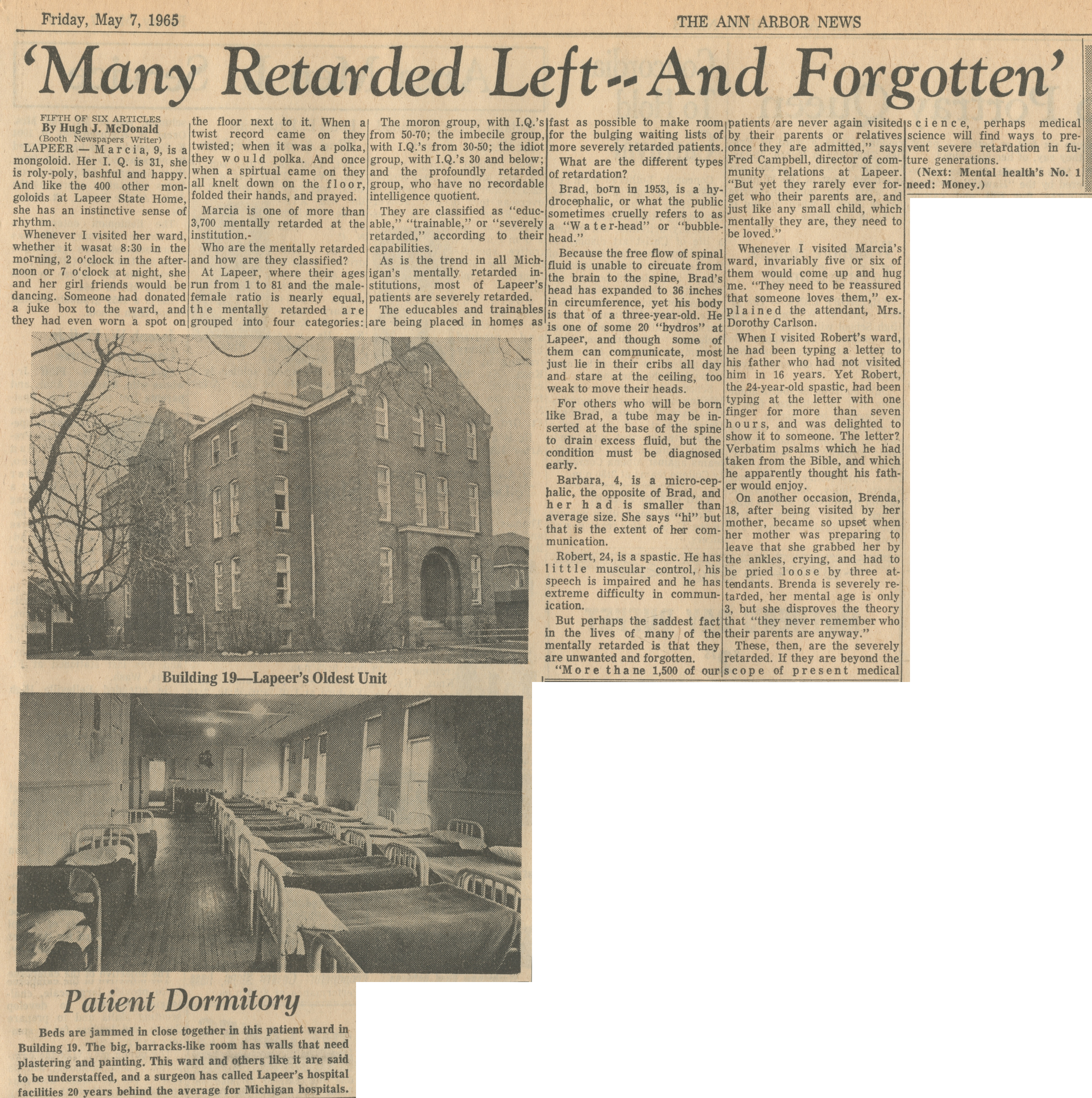Many Retarded Left -- And Forgotten

Friday, May 7, 1965 THE ANN ARBOR NEWS
‘Many Retarded Left - And Forgotten’
FIFTH OF SIX ARTICLES
By Hugh J. McDonald
(Booth Newspapers Writer)
LAPEER -- Marcia, 9, is a mongoloid. Her I. Q. is 31, she is roly-poly, bashful and happy. And like the 400 other mongoloids at Lapeer State Home, she has an instinctive sense of rhythm.
Whenever I visited her ward, whether it was at 8:30 in the morning, 2 o'clock in the afternoon or 7 o'clock at night, she and her girl friends would be dancing. Someone had donated a juke box to the ward, and they had even worn a spot on the floor next to it. When a twist record came on they twisted; when it was a polka, they would polka. And once when a spiritual came on they all knelt down on the floor, folded their hands, and prayed.
Marcia is one of more than 3,700 mentally retarded at the institution.
Who are the mentally retarded and how are they classified?
At Lapeer, where their ages run from 1 to 81 and the male-female ratio is nearly equal, the mentally retarded are grouped into four categories:
The moron group, with I.Q.’s from 50-70; the imbecile group, with I.Q.’s from 30-50; the idiot group, with I.Q.’s 30 and below; and the profoundly retarded group, who have no recordable intelligence quotient.
They are classified as "educable,” “trainable,” or “severely retarded,” according to their capabilities.
As is the trend in all Michigan’s mentally retarded institutions, most of Lapeer’s patients are severely retarded.
The educables and trainables are being placed in homes fast as possible to make room for the bulging waiting lists of more severely retarded patients.
What are the different types of retardation?
Brad, born in 1953, is a hydrocephalic, or what the public sometimes cruelly refers to as a “Water-head” or “bubble-head.”
Because the free flow of spinal Quid is unable to circulate from the brain to the spine, Brad’ head has expanded to 36 inches in circumference, yet his body is that of a three-year-old. He is one of some 20 “hydros” at Lapeer, and though some of them can communicate, most just lie in their cribs all day and stare at the ceiling, too weak to move their heads.
For others who will be born like Brad, a tube may be inserted at the base of the spine to drain excess fluid, but the condition must be diagnosed early.
Barbara, 4, is a micro-cephalic, the opposite of Brad, and her had is smaller than average size. She says “hi” but that is the extent of her communication.
Robert, 24, is a spastic. He has little muscular control, his speech is impaired and he has extreme difficulty in communication.
But perhaps the saddest fact in the lives of many of the mentally retarded is that they are unwanted and forgotten.
“More than 1,500 of our patients are never again visited by their parents or relatives once they are admitted,” says Fred Campbell, director of community relations at Lapeer. “But yet they rarely ever forget who their parents are, and just like any small child, which mentally they are, they need to be loved.”
Whenever I visited Marcia’s ward, invariably five or six of them would come up and hug me. “They need to be reassured that someone loves them,” explained the attendant, Mrs. Dorothy Carlson.
When I visited Robert’s ward, he had been typing a letter to his father who had not visited him in 16 years. Yet Robert, the 24-year-old spastic, had been typing at the letter with one finger for more than seven hours, and was delighted to show it to someone. The letter? Verbatim psalms which he had taken from the Bible, and which he apparently thought his father would enjoy.
On another occasion, Brenda, 18, after being visited by her mother, became so upset when her mother was preparing to leave that she grabbed her by the ankles, crying, and had to be pried loose by three attendants. Brenda is severely retarded, her mental age is only 3, but she disproves the theory that “they never remember who their parents are anyway.” These, then, are the severely retarded. If they are beyond the cope of present medical science, perhaps medical science will find ways to prevent severe retardation in future generations.
(Next: Mental health’s No. 1 need: Money.)
PHOTO: Building 19—Lapeer’s Oldest Unit
PHOTO: Patient Dormitory
Beds are jammed in close together in this patient ward in Building 19. The big, barracks-like room has walls that need plastering and painting. This ward and others like it are said to be understaffed, and a surgeon has called Lapeer’s hospital facilities 20 years behind the average for Michigan hospitals.